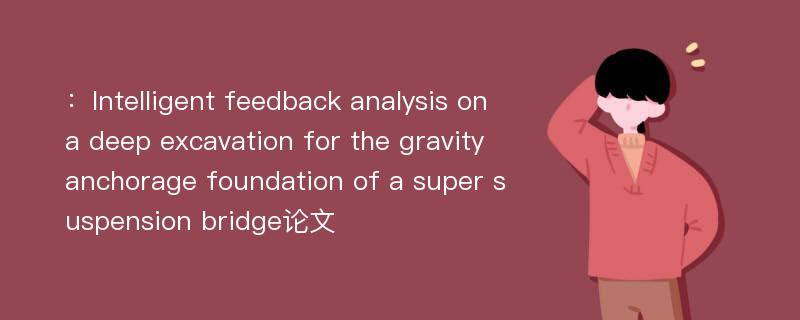
本文主要研究内容
作者(2019)在《Intelligent feedback analysis on a deep excavation for the gravity anchorage foundation of a super suspension bridge》一文中研究指出:In order to ensure the construction safety of the 38.5 m deep excavation for the gravity anchorage foundation of Fuma Yangtze River Bridge, an intelligent feedback analysis was applied to this excavation project. First, a three-dimensional numerical model that simulating the construction process of the excavation was built,and the deformations of the supporting structures were calculated by the finite difference program FLAC3 D. Then,the non-linear mapping relationship between the geomechanical parameters and the excavation-induced displacements was established by the back-propagation neural network(BPNN). Last,the geomechanical parameters were optimized intelligently by the genetic algorithm(GA) based on the developed BPNN model and the measured displacements,and the deformations during the subsequent excavation stages were predicted based on the back-calculated parameters. The research results showed that:the back-calculated values of E1,μ1,c1,and φ1 of the completely weathered stratum,and E2 of the heavily weathered stratum were greater than the initial values,while the inversion value of E3 of the moderately weathered stratum was smaller than the initial value. The magnitudes and the variation tendencies of the predicted displacements were in good accordance with the measured displacements. At the end of the excavation,the retaining piles and the top beams had a maximum displacement of 15–20 mm,exhibiting a quite small magnitude as comparing with other case histories. Local concentration of shear stress mainly occurred at the soil-pile interface and at the toe of the excavation slope,and the plastic zones mainly appeared in the completely weathered stratum. After the completion of the excavation,there were no yielding elements in the model,and the convergence of the numerical computation was achieved,indicating the excavation was in a stable state. This study lays the basis for the subsequent construction and operation of the bridge,and offers a significant reference for the feedback analysis of similar anchorage excavation projects.
Abstract
In order to ensure the construction safety of the 38.5 m deep excavation for the gravity anchorage foundation of Fuma Yangtze River Bridge, an intelligent feedback analysis was applied to this excavation project. First, a three-dimensional numerical model that simulating the construction process of the excavation was built,and the deformations of the supporting structures were calculated by the finite difference program FLAC3 D. Then,the non-linear mapping relationship between the geomechanical parameters and the excavation-induced displacements was established by the back-propagation neural network(BPNN). Last,the geomechanical parameters were optimized intelligently by the genetic algorithm(GA) based on the developed BPNN model and the measured displacements,and the deformations during the subsequent excavation stages were predicted based on the back-calculated parameters. The research results showed that:the back-calculated values of E1,μ1,c1,and φ1 of the completely weathered stratum,and E2 of the heavily weathered stratum were greater than the initial values,while the inversion value of E3 of the moderately weathered stratum was smaller than the initial value. The magnitudes and the variation tendencies of the predicted displacements were in good accordance with the measured displacements. At the end of the excavation,the retaining piles and the top beams had a maximum displacement of 15–20 mm,exhibiting a quite small magnitude as comparing with other case histories. Local concentration of shear stress mainly occurred at the soil-pile interface and at the toe of the excavation slope,and the plastic zones mainly appeared in the completely weathered stratum. After the completion of the excavation,there were no yielding elements in the model,and the convergence of the numerical computation was achieved,indicating the excavation was in a stable state. This study lays the basis for the subsequent construction and operation of the bridge,and offers a significant reference for the feedback analysis of similar anchorage excavation projects.
论文参考文献
论文详细介绍
论文作者分别是来自岩石力学与工程学报的,发表于刊物岩石力学与工程学报2019年S1期论文,是一篇关于,岩石力学与工程学报2019年S1期论文的文章。本文可供学术参考使用,各位学者可以免费参考阅读下载,文章观点不代表本站观点,资料来自岩石力学与工程学报2019年S1期论文网站,若本站收录的文献无意侵犯了您的著作版权,请联系我们删除。
